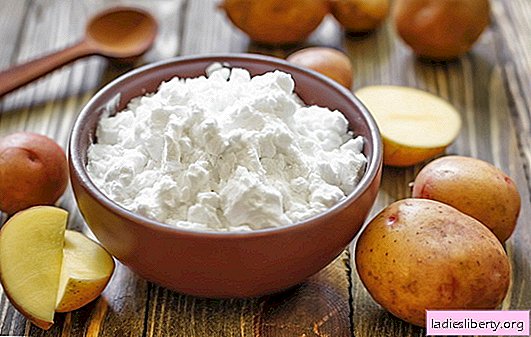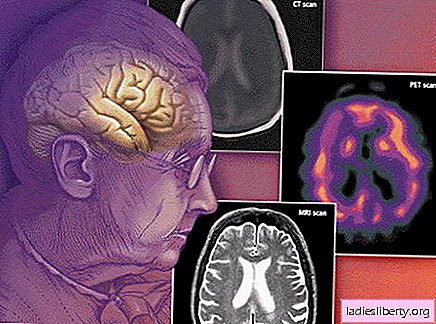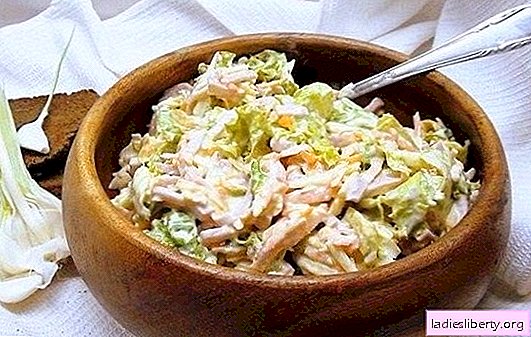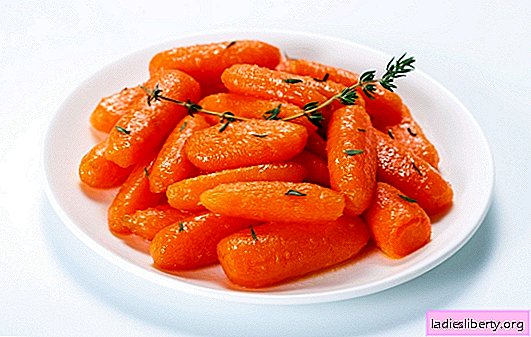
Starch is a polysaccharide belonging to the group of complex carbohydrates.
It is the most common polysaccharide that is constantly present in the diet.
Starch: composition as used
The product is a free flowing white, rarely yellowish, odorless and tasteless powder. It does not dissolve in cold water, but when ingested, it forms a significant amount of colloidal particles, a large concentration of which creates a viscous and thick mass (paste). If the starch is rubbed between the fingers or squeezed in the palm of your hand, you will hear a characteristic creaking. Such a sound is created by its small particles when rubbing against each other. They are quite solid and even with such an impact are not destroyed.
Starch is present in many plants: peas, bananas, beans, mangoes, tubers and root crops. The polysaccharide that a person uses as an additive is made from rice, wheat, potatoes, corn and chestnuts.
Starch - high-calorie polysaccharide, at 100 grams there are 313 Kcal. Such a high caloric content is useful for a mobile and strong person who spends a large amount of energy per day and constantly needs calories. With an active lifestyle, all starch-based products are invaluable to the body.
Ratio of fats, proteins and carbohydrates (energy value of the product):
• fat - 0gr (0kcal);
• proteins - 0.1g (0kcal);
• carbohydrates - 78.2 gr (313 Kcal).
The nutritional value:
• starch - 77.3 g;
• water - 20g;
• dietary fiber - 1.4g;
• mono - and disaccharides - 0.9 g;
• ash - 0.3 gr.
These figures only once again confirm the fact of the high caloric content of starch and its saturation with carbohydrates.
Starch can not boast of a rich mineral and vitamin composition. It contains:
• vitamin PP (0,0166mg);
• mineral substances: sodium (6 mg), potassium (15 mg), calcium (40 mg), phosphorus (77 mg).
The carbohydrate is used in cooking, cosmetology, pharmacology, medicine, in a number of industries:
• In pharmacology used as a filler in all tablet preparations. It is present in baby powder, ointment. On its basis, syrups, mixtures, sorbitol, glucose are produced.
• In medicine it is recommended to regularly drink kissel in case of intoxication, gastritis, ulcers. Starch in its composition obtyagivaet the walls of the intestine and stomach, protects their mucous membranes. Eliminate spurs on the heel, relieve irritation on the skin, and reduce starch helps to reduce diaper rash.
• In cosmetology: masks, creams, in which one of the ingredients is starch, nourish and soften the skin. These cosmetics do not cause an allergic reaction and are recommended for any skin type.
• Use in cooking and food industry. Due to the fact that starch can form a colloidal solution, it is used in the manufacture of gravies, various sauces, mayonnaise, jelly, desserts, creams. Often flour for baking is partially replaced by starch. Such a replacement makes the product crumbly, more tender. Carbohydrate is an essential ingredient in many meat products, such as sausages, sausages, minced meat. In these products, it is necessary to create a dense consistency.
• Use in the pulp and textile industries. In the pulp industry, it is necessary for the processing of paper and is its filler. The textile is used for processing fabrics.
The beneficial properties of starch make it possible to apply it so widely.
Starch: what is the benefit for the body
Whatever rumors go about starch, it was and remains the most important product in the diet. Its insignificant mineral and vitamin composition makes this product valuable for humans:
• Vitamin PP. Despite the fact that it is the only vitamin in starch, its effect on the body cannot be underestimated: it is an indispensable participant in all reduction and oxidative processes, converts fats and sugars into energy, reduces the amount of cholesterol, stimulates the work of many organs, regulates the formation of red blood cells, supports hormone levels, acts as a sedative for the nervous system.
• Sodium maintains osmotic pressure and balance of water in the body, participates in the transport of carbon dioxide, amino acids, participates in the metabolism of proteins and activates the activity of enzymes.
• Potassium regulates the water - salt balance, protein and carbohydrate metabolism, is important for protein synthesis, affects the functioning of the liver, kidneys, intestines, heart.
• Calcium It is necessary for the heart to work, it coordinates all intracellular processes, it affects the blood clotting and the condition of the bone system, teeth.
• Phosphorus affects the growth and recovery of the body, normalizes all energy exchanges and acid - base balance, improves the metabolism process, affects cell division, enzyme synthesis.
Combining the properties of each of these components, we can conclude that the use of starch for the body is that:
• contributes to the removal of excess water from the body;
• helps to fight a person with inflammations;
• inhibit the growth and spread of malignant cells;
• should be present in the diet of patients with diabetes, because it reduces the intensity, the rate of absorption of sugars by the body, thereby reducing their concentration;
• is an energetic “feed” and can provide a person with a daily intake of carbohydrates;
• strengthens the immune system;
• normalizes digestion and metabolism;
• reduces adverse to diabetics consequences of raising the sugar index;
• reduces acidity in the stomach, reduces the risk of ulcers;
• maintains skin, hair, and nails in good condition.
The beneficial properties of starches have been known for a long time and have been widely used by traditional medicine. Starch has found its use in the treatment of diseases of the duodenum, stomach, and colds.
Uncontrolled use of starch in order to eliminate health problems is not worth it. It is important that its health benefits do not turn into harm.
Starch: what is the harm to health
Starch can be called a dual product. On the one hand, it is a “treasure” of useful and valuable properties, and on the other, it harbors harm.
Starch is of 2 types:
1. natural (fruits, cereals, legumes, nuts, vegetables);
2. refined, obtained industrially: starch and flour of the highest grade (white), all food products from them.
Harmful are just refined types of starch. Their harm to health lies in the fact that when they are digested by the body, they all:
• able to increase insulin levels;
• lead to the development of atherosclerosis;
• violate the hormonal balance;
• thin the walls of blood vessels;
• increases the risk of developing various diseases of any organ, especially the pancreas and stomach;
• cause stomach upset, flatulence;
• cause the appearance of symptoms similar to the symptoms of a cold: sneezing, liquid nasal discharge;
• nausea, vomiting, choking, speech disorder;
• lead to pathological changes in the eyeball and retina.
It is proved that a significant content of starch in products subjected to heat treatment, increase the chance of developing oncology. Ordinary and favorite buns, pies can cause malignant tumors.
In order for the body to digest products from starch, it is forced to use those blood enzymes that help a person cope with stress, poor health, depression. In a situation when these enzymes become necessary for the organism, their quantity is insufficient.
Frequent use of products based on it is not recommended for those who are overweight. The constant presence in the diet of this product leads to the accumulation of energy, which will certainly lead in the future to the accelerated formation of fat cells.
Starch for children: useful or harmful
Starch of natural origin can not harm the health of the child. On the contrary, it protects and helps the child's body. It can be found in the composition of baby food.
There are several reasons for including this polysaccharide in baby food:
1. Able to bind excess liquid. Due to this property vegetable, fruit puree becomes homogeneous, do not spread.
2. It helps the child to digest a new food for him, and its fixing properties prevents diarrhea.
3. Splitting, starch is an indispensable source of glucose, which is necessary for brain function.
4. Protects the baby's stomach from the action of organic acids present in the puree.
Studies show that starch is a completely safe product for a newborn baby. From the first days his ventricle easily splits it into glucose. That is why the polysaccharide is present in the composition of dairy baby formula, is their thickener, prevents regurgitation.
The presence of starch in baby food is minimal: only 3% - 10%. Such a volume of the child's body is easily digested and receives only benefit. For the production of baby food used rice and corn starch.
It is up to parents to trust starch and use food based on it or not. The main thing is to choose the products of those manufacturers who have earned the trust and have proven themselves only from the best side. Such a choice will guarantee that only healthy, high-quality, fresh products will be present in the baby’s diet.
There are no uniquely useful products. Even if there is a mass of useful properties in the product, there will be at least one that will negatively affect the body. This feature applies to starch.











